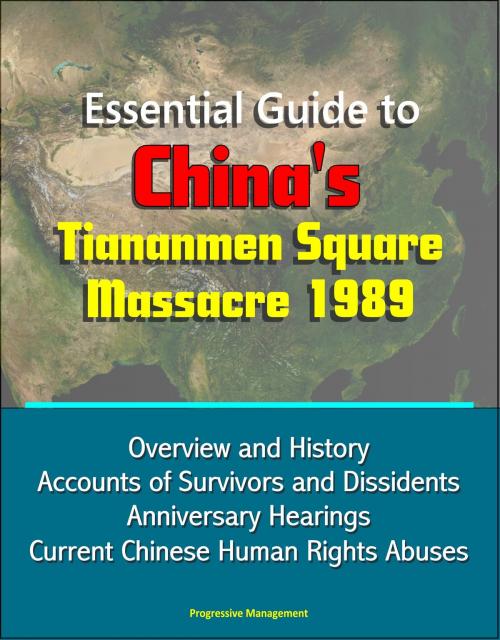Essential Guide to China's Tiananmen Square Massacre 1989: Overview and History, Accounts of Survivors and Dissidents, Anniversary Hearings, Current Chinese Human Rights Abuses
Nonfiction, History, Asian, China, Social & Cultural Studies, Political Science| Author: | Progressive Management | ISBN: | 9781311863775 |
| Publisher: | Progressive Management | Publication: | June 8, 2014 |
| Imprint: | Smashwords Edition | Language: | English |
| Author: | Progressive Management |
| ISBN: | 9781311863775 |
| Publisher: | Progressive Management |
| Publication: | June 8, 2014 |
| Imprint: | Smashwords Edition |
| Language: | English |
This unique ebook provides a comprehensive overview of the June 1989 Tiananmen Square massacre in China on the occasion of the 25th anniversary, featuring histories, accounts of survivors and Chinese dissidents, hearings held by the U.S. Congress and the Congressional - Executive Commission on China (CECC), and stories of current Chinese human rights abuses. It includes the complete reproduction of a major Department of Defense report, Chinese National Security Decisionmaking Under Stress, which includes a major discussion of the Tiananmen Square massacre.
The People's Liberation Army (PLA) of Communist China massed elements of more than a dozen infantry, armor, and airborne divisions around the city of Beijing in May and June 1989. Workers and students precipitated this massing of military force by demonstrating inside the city for more political expression and against nepotism and rampant corruption in the Chinese Communist Party (CCP). For weeks the CCP senior leadership was divided about how to handle the demonstrations. The political divisions in the highest ranks of the Party paralyzed decisionmaking and reflected ambivalence, even outright disagreement, in the PLA over the use of the military to suppress the unrest. A number of older, retired Communist Party members who fought to take control of China from the 1920s through 1949 emerged with comments and advice.1 Many pushed for the suppression of the demonstrations by the PLA. Younger, reform-minded Party members coalesced around General Secretary Zhao Ziyang as he pushed for greater openness and economic liberalization.
This situation leading up to the Tiananmen Massacre is best characterized as a process of decisionmaking under stress. Initially the Communist Party Politburo Standing Committee (PBSC) was torn internally about how to respond, and the lack of response from student demonstrators put them under considerable stress. Later in the process, however, when it was clear that attempts to communicate with the students would not end the demonstrations, and the demonstrations spread throughout China on a larger scale, what had been a stressful situation became a genuine crisis.
In the end, the more orthodox Communists and other factions inside the Party who resisted any shift in the distribution of wealth and power won out. The students were suppressed with deadly force.
The disagreements over the pace of reform and the role of the Communist Party in the Chinese state that led to the slaughter of demonstrators and innocents alike in Beijing was really the extension of an earlier dispute about reform within the CCP that resulted in the dismissal of CCP General Secretary Hu Yaobang approximately 2 years earlier. It was Hu Yaobang's death on April 15, 1989, that threw the Communist Party leadership into turmoil and paralyzed inner-Party decisionmaking at the highest levels. The lesson from this chapter is that the consensus-related system of power among factions at the top of the Communist Party created, and will likely continue to create, paralysis in decisionmaking, thus delaying the ability of the CCP to react and potentially exacerbating any crisis.
This unique ebook provides a comprehensive overview of the June 1989 Tiananmen Square massacre in China on the occasion of the 25th anniversary, featuring histories, accounts of survivors and Chinese dissidents, hearings held by the U.S. Congress and the Congressional - Executive Commission on China (CECC), and stories of current Chinese human rights abuses. It includes the complete reproduction of a major Department of Defense report, Chinese National Security Decisionmaking Under Stress, which includes a major discussion of the Tiananmen Square massacre.
The People's Liberation Army (PLA) of Communist China massed elements of more than a dozen infantry, armor, and airborne divisions around the city of Beijing in May and June 1989. Workers and students precipitated this massing of military force by demonstrating inside the city for more political expression and against nepotism and rampant corruption in the Chinese Communist Party (CCP). For weeks the CCP senior leadership was divided about how to handle the demonstrations. The political divisions in the highest ranks of the Party paralyzed decisionmaking and reflected ambivalence, even outright disagreement, in the PLA over the use of the military to suppress the unrest. A number of older, retired Communist Party members who fought to take control of China from the 1920s through 1949 emerged with comments and advice.1 Many pushed for the suppression of the demonstrations by the PLA. Younger, reform-minded Party members coalesced around General Secretary Zhao Ziyang as he pushed for greater openness and economic liberalization.
This situation leading up to the Tiananmen Massacre is best characterized as a process of decisionmaking under stress. Initially the Communist Party Politburo Standing Committee (PBSC) was torn internally about how to respond, and the lack of response from student demonstrators put them under considerable stress. Later in the process, however, when it was clear that attempts to communicate with the students would not end the demonstrations, and the demonstrations spread throughout China on a larger scale, what had been a stressful situation became a genuine crisis.
In the end, the more orthodox Communists and other factions inside the Party who resisted any shift in the distribution of wealth and power won out. The students were suppressed with deadly force.
The disagreements over the pace of reform and the role of the Communist Party in the Chinese state that led to the slaughter of demonstrators and innocents alike in Beijing was really the extension of an earlier dispute about reform within the CCP that resulted in the dismissal of CCP General Secretary Hu Yaobang approximately 2 years earlier. It was Hu Yaobang's death on April 15, 1989, that threw the Communist Party leadership into turmoil and paralyzed inner-Party decisionmaking at the highest levels. The lesson from this chapter is that the consensus-related system of power among factions at the top of the Communist Party created, and will likely continue to create, paralysis in decisionmaking, thus delaying the ability of the CCP to react and potentially exacerbating any crisis.















